Corn Diseases Associated with Early Planting
May 13, 2024
- Seed and seedling diseases can reduce viable plant populations.
- The potential for early season disease infections can increase when the soil is cold and wet.
- Injury to corn seedlings by insects can mimic disease symptoms.
The potential for corn seeds and seedling plants to become infected with a disease is influenced by many factors including growing conditions, the use of fungicidal seed treatments, planting dates, previous crop residue, and the presence of fungal or bacterial pathogens, viral vectors, and nematodes. Genetic improvements in germination and seedling growth characteristics under cool growing conditions are several factors that can allow corn planting to take place earlier than in the past.
Newly planted seeds can be subjected to soil borne pathogenic fungi and bacteria that can infect the seeds, seedling tissue, or both. Disease pathogens generally have a greater potential for causing damage when the soil is wet and cold; however, some pathogens prefer warm conditions. Infected seedlings may show signs of damping-off, rot, stunting, leaf discoloration, and deformities. Fungicidal seed treatments, direct and systemic, can help protect seeds from fungal pathogens. Fungicides do not protect seeds or seedlings from bacterial or viral diseases.
Adult insects or insect larvae, including seed corn maggot, seed corn beetle, garden symphylan, wireworm, billbug, true white grub, stink bugs, cutworm, grape colaspis grub, and corn flea beetle, may feed on seeds or seedlings and cause damage mimicking disease symptoms. Injury due to insects may appear as stunted, wilted, discolored, or dead plants (Figure 1). Therefore, it is important to dig up seedling plants to closely examine below ground tissue for evidence of insect feeding. Corn flea beetles, while feeding, can transmit the bacterium that causes Stewart’s bacterial wilt, which has a seedling phase and a later-season phase. If it is determined that insects are the cause for seedling death, then insect activity may need to be addressed depending on the life cycle and threshold for each insect. For additional information on seedling corn insects and management, please see Managing Seed and Seedling Insect Pest in Corn and Do I Need to Apply an Insecticide to Manage Early-Season Corn Insects?
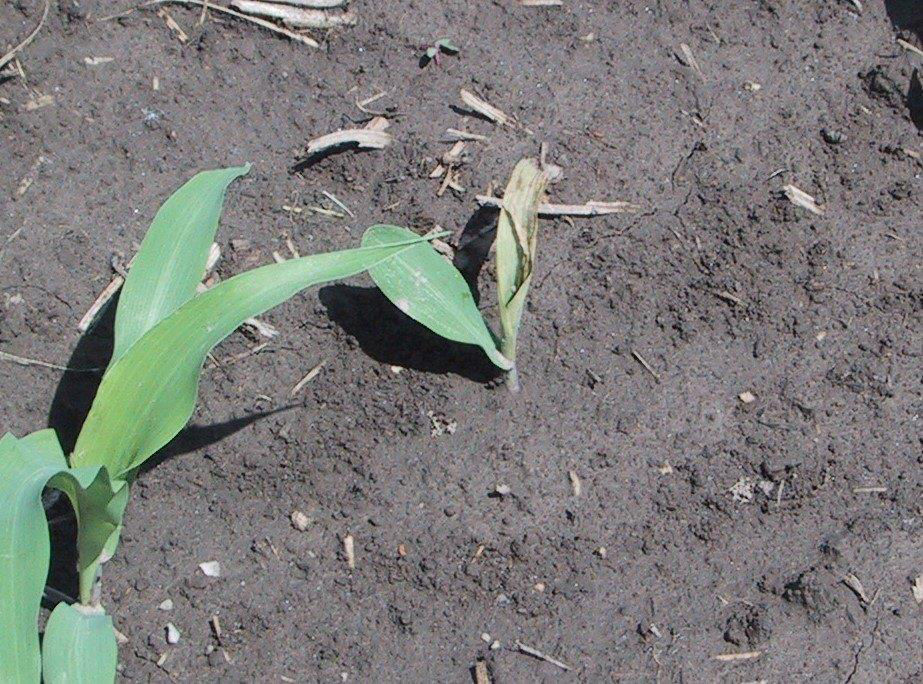
Depending on growing conditions and crop residue, infection for some foliar diseases may occur during the seedling stage; however, symptoms may not appear until later in the growing season. Foliar diseases that may infect seedling corn include anthracnose leaf blight, Holcus leaf spot, and Goss’s bacterial wilt.
Early season scouting is important to identify emergence issues and determine a course of action. Randomized population counts across the field should be made to determine the population levels of healthy plants. These counts, compared to projected potential yield based on planting date, can help a grower determine if replanting corn is necessary and profitable. For additional information on replanting corn, please see Corn Replanting Decisions.
Considerations to help reduce the potential for seedling disease development include:
- Rotate crops to reduce crop specific disease pathogens living on crop residue.
- Improve soil drainage through compaction alleviation, subsurface drainage, and where practical, conservation minded surface drainage.
- Select seed products with high scores for emergence and rapid seedling growth.
- Invest in fungicidal and insecticidal seed treatments.
- Plant when the forecast calls for a period of warm weather without cold rain.
Seed and Seedling Diseases
Fusarium
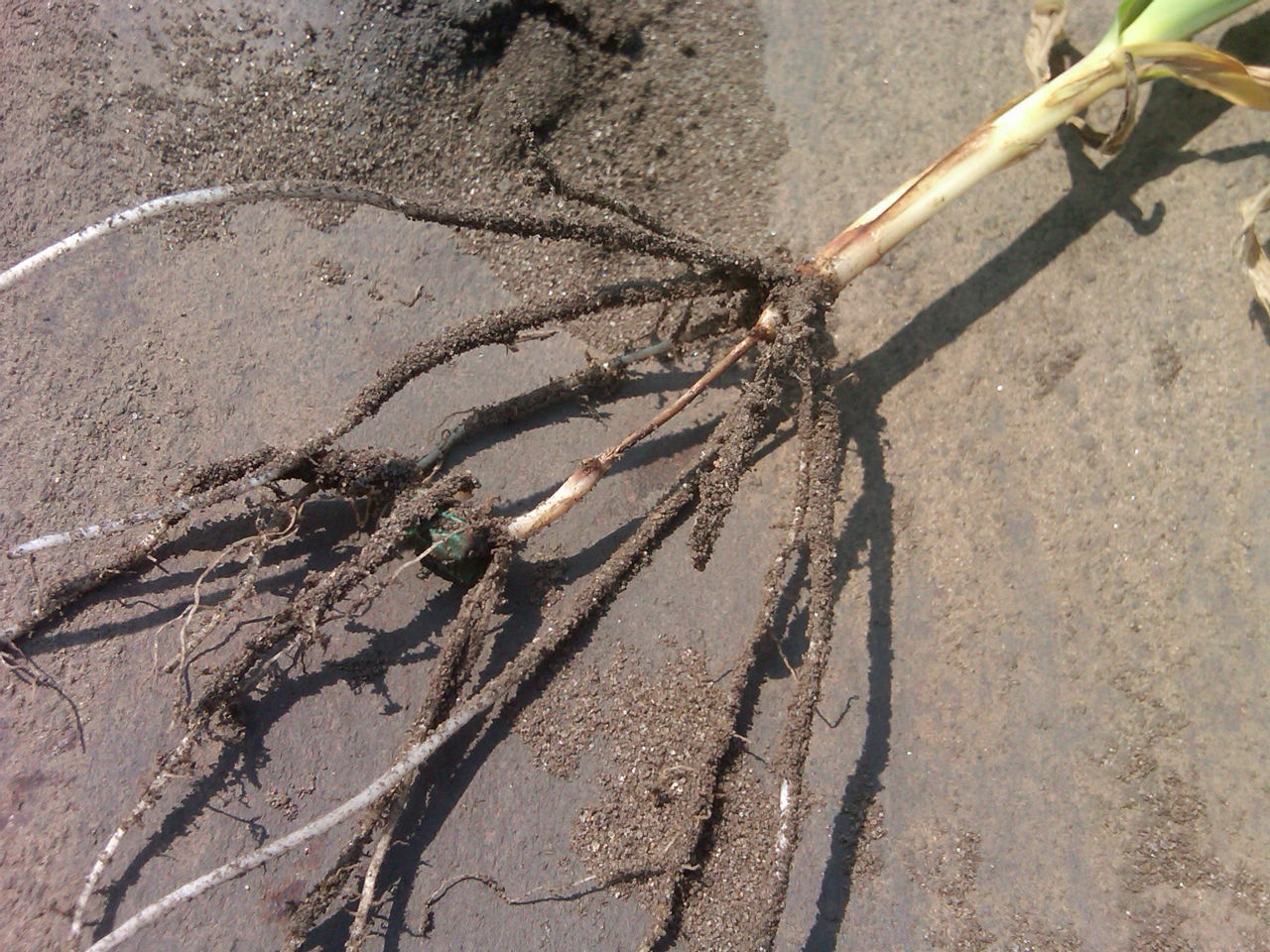
Identification, Characteristics, and Diagnosis:
- Caused by at least six Fusarium species.
- Infected seedling roots and the mesocotyl may initially be shriveled and have tan to reddish-brown lesions, which later become brownish to dark black and rotted (Figure 2).
- Infection is favored by wet and cool (55 °F or lower) soils.
- Most likely to occur in early planted and reduced tillage fields.
Management:
- Use fungicide-protected seed.
- Plant into warm, dry soil.
- Plant at the recommended seeding depth.
Penicillium
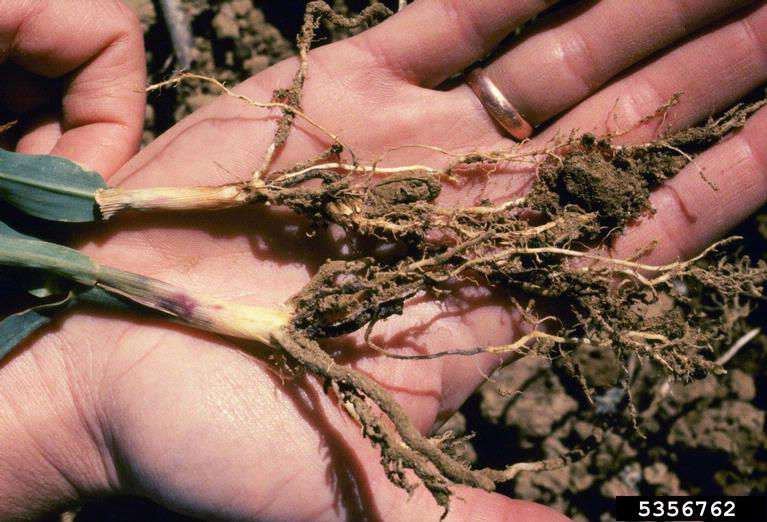
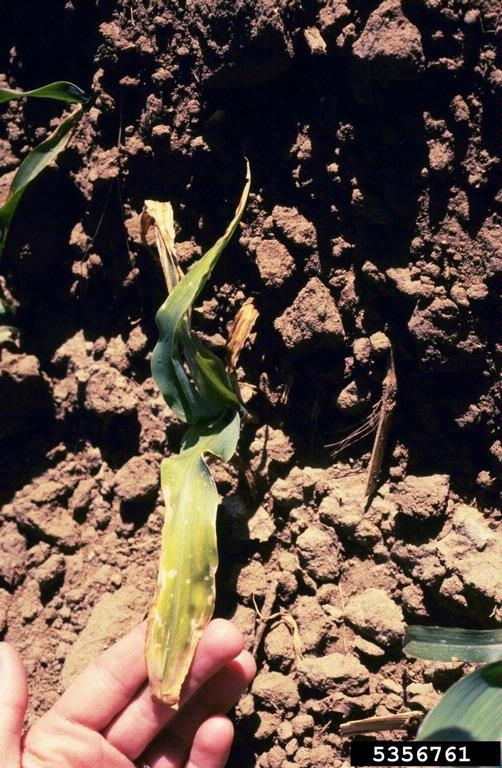
Identification, Characteristics, and Diagnosis:
- Caused by the fungus Penicillium oxalicum.
- A bluish-green mold develops on seed causing roots to deteriorate (Figure 3).
- Seedling leaves turn yellow and may die (Figure 4).
- Infection is favored by wet and cool (55 °F or lower) soils.
- Penicillium is most likely to occur in early planted and reduced tillage fields.
Management:
- Use fungicide-protected seed.
- Plant into warm, dry soil.
- Plant at the recommended seeding depth.
Pythium
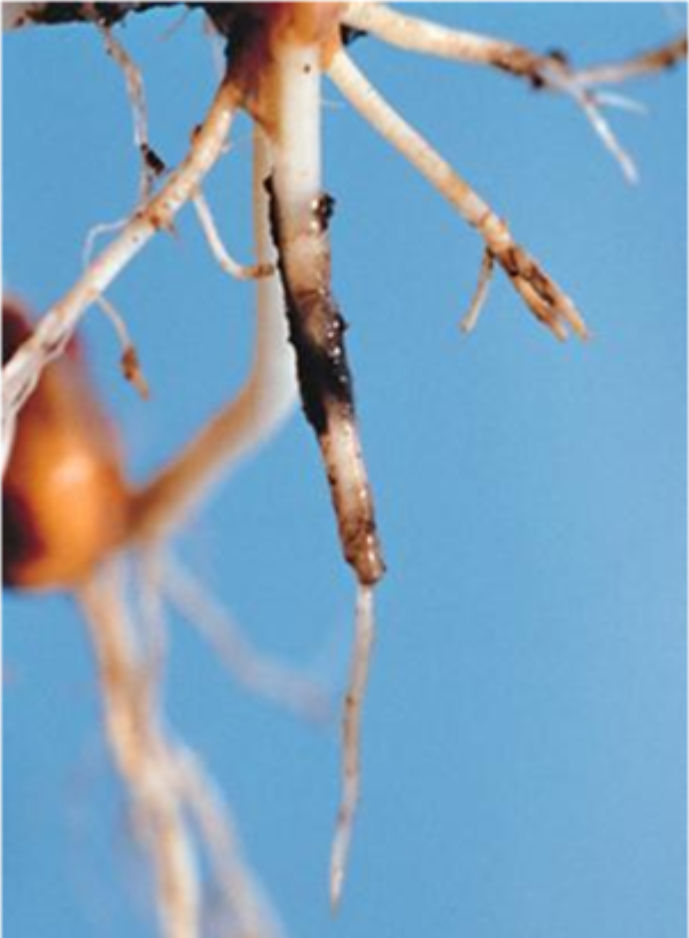
Identification, Characteristics, and Diagnosis:
- Caused by several Pythium species.
- Infection is favored by wet and cool (55 °F or lower) soils, depending on the Pythium species present.
- Symptoms include dark, slimy lesions that cause roots or the mesocotyl to shrivel. The outer layer of roots may rot while inner tissues remain white and intact (Figure 5).
- Pythium is most likely to occur in early planted and reduced tillage fields.
- Can infect anytime from planting to mid-season.
Management:
- Use fungicide-protected seed.
- Plant into warm, dry soil.
- Plant at the recommended seeding depth.
Rhizoctonia
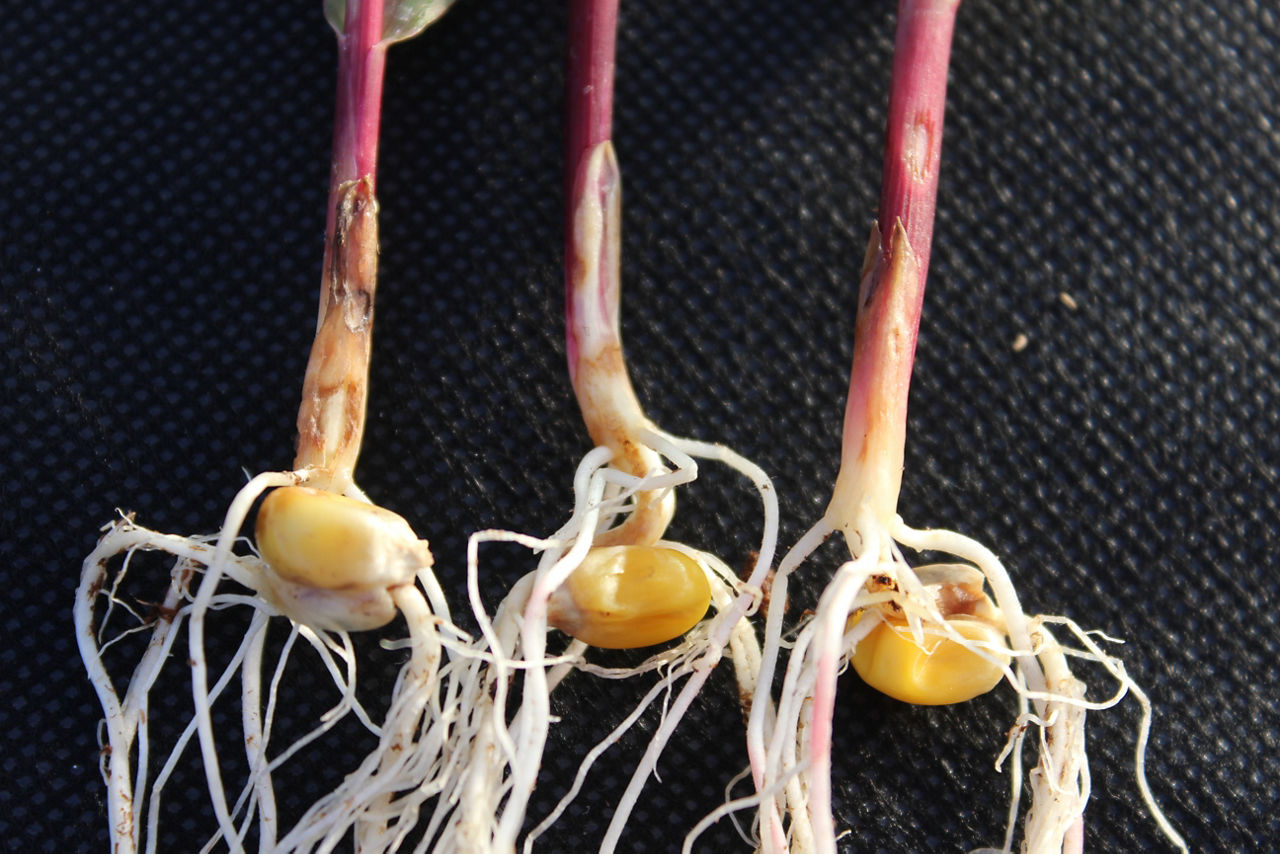
Identification, Characteristics, and Diagnosis:
- Caused by the fungus Rhizoctonia solani.
- Initial symptoms include brown lesions on the mesocotyl and roots of seedlings and young plants (Figure 6).
- Later symptoms on older plants include dry, reddish-brown, sunken cankers on crown and brace roots.
- Plants may be stunted, chlorotic, or have no above ground symptoms.
- Typically occurs in irrigated fields.
- Infection is favored by temperatures between 46 and 82 °F.
Management:
- Use fungicide-protected seed.
- Plant into warm, dry soil.
- Plant at the recommended seeding depth
Other Diseases that May Infect Seedling Corn
Anthracnose Leaf Blight
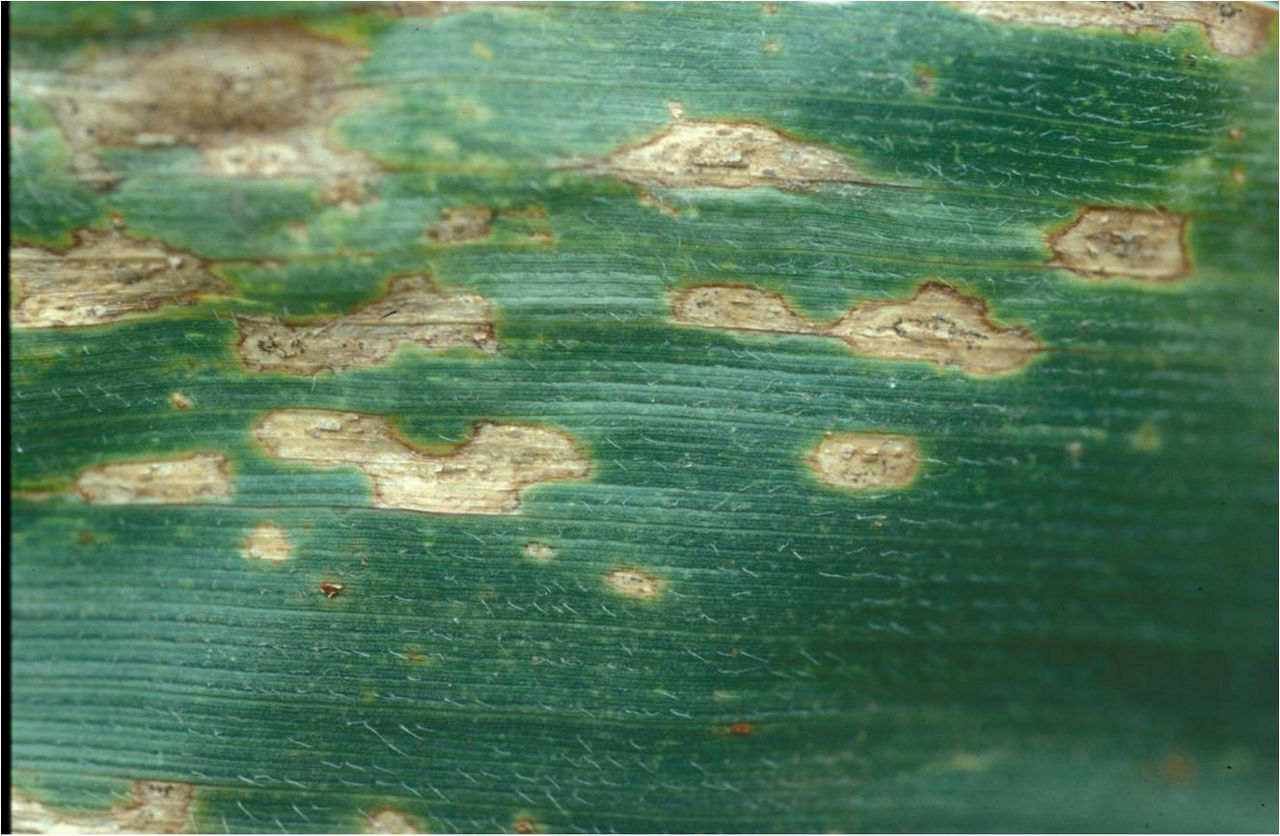
Identification, Characteristics, and Diagnosis:
- Caused by the fungus Colletotrichum graminicola.
- This disease can have three phases – leaf blight, top dieback, and stalk rot.
- Under severe levels of infection, yield losses may be as high as 40%.
- Roots and foliage of seedlings can become infected from residue when warm, rainy conditions exist during the spring. If young roots are infected, the disease may not be observed until later in the season.
- Infection is favored by warm, rainy, and overcast conditions.
- Splashing rain can move spores from residue to plants.
- Leaf lesions are small, oval to irregular, brown to red brown, often have a yellow margin, can have a “target-like” appearance, and microscopic black hair-like structures may appear within the lesion (Figure 7).
Management:
- Plant seed products that are rated high for tolerance to anthracnose leaf blight..
- Manage residue through tillage, chopping, shredding, and/or disking.
- Avoid planting corn in consecutive years especially in no-till fields with a history of infection.
- Rotate crops.
- Manage stress factors.
Goss’s Wilt

Identification, Characteristics, and Diagnosis:
- Caused by the bacterium Clavibacter michiganensis subsp. nebraskensis.
- Symptoms include wavy-edged leaf lesions, dark green to black water-soaked spots (freckles) near the edge of the lesions, and an ooze or exudate within the lesion that appears shiny when dry (Figure 8).
- The disease has a stalk rot phase.
- The pathogen can survive from season to season in crop residue on the soil surface and be transported to plants by irrigation, splashing rain, or in windblown infested particles.
- The bacterium enters plants through wounds caused by hail, wind, sand blasting, and other injurious causes.
- The pathogen is rarely transmitted within the seed.
Management:
- Plant seed products with high ratings for tolerance to Goss’s wilt.
- Foliar fungicides DO NOT provide protection for bacterial diseases.
- Prior to leaving an infested field, residue should be removed from equipment.
- Crop rotation and tillage may help degrade infected residue.
- Control alternative hosts that include green foxtail (Setaria viridis), shattercane (Sorghum bicolor), and barnyard grass (Echinochloa crus-galli).
Holcus Leaf Spot
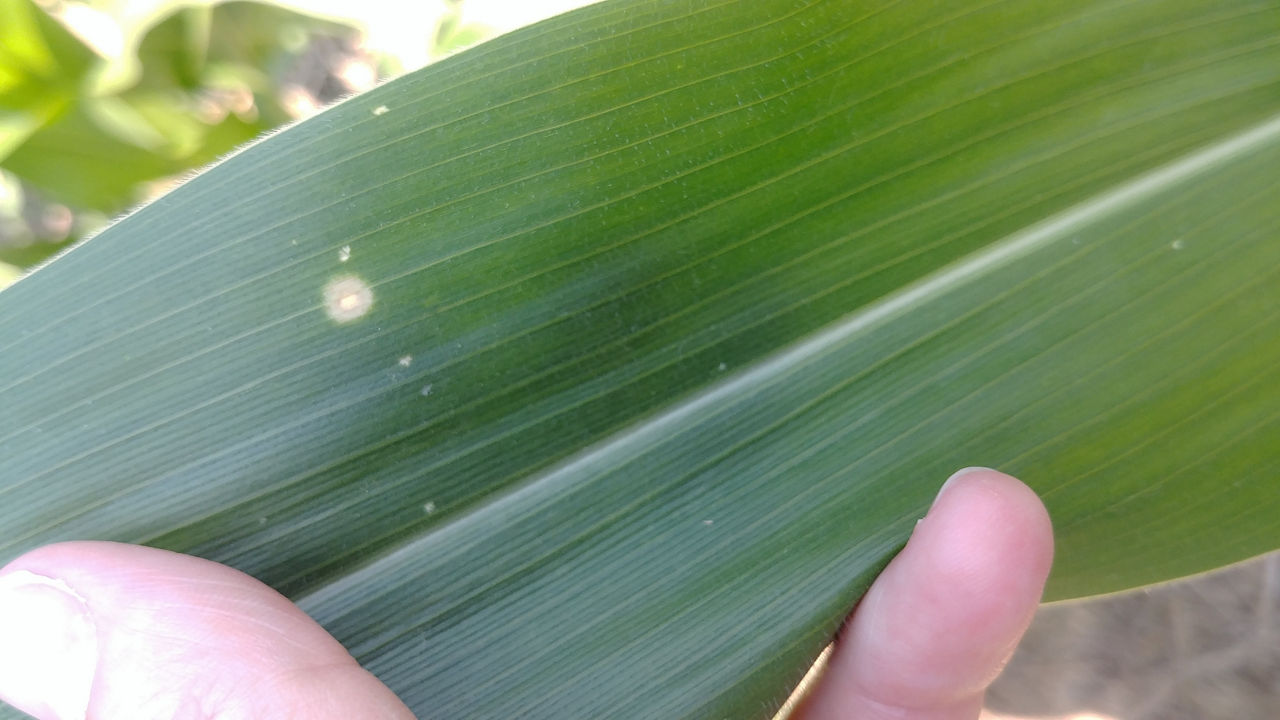
Identification, Characteristics, and Diagnosis:
- Caused by the bacterium Pseudomonas syringae pv. syringae van Hall.
- Symptoms initially appear as water-soaked, dark-green lesions on the tips of lower leaves. More mature lesions are round to elliptical, tan to white spots with red to brown margins, and 1/8 to 1/4 inch in diameter. Yellow halos may surround the spots (Figure 9).
- Symptoms can be confused with injury resulting from paraquat herbicide drift.
- The bacterium enters plants through wounds caused by hail, wind, sand blasting, and other injurious causes.
- Infection is favored by wet weather and warm temperatures (76 to 86 °F).
- The bacterium overwinters on infected crop residue.
- The bacteria may have ice nucleating capabilities that can enhance frost injury.
Management:
- Rotate crops to help reduce residue.
- Tillage can help promote residue decomposition.
- Foliar fungicides DO NOT provide protection for bacterial diseases.
- Prior to leaving an infested field, residue should be removed from equipment.
Stewart’s Bacterial Wilt

Identification, Characteristics, and Diagnosis:
- Caused by the bacterium Pantoea stewartii.
- The bacterium is transmitted to plants by corn flea beetle (Chaetocnema hortensis) feeding.
- Most commercial corn products have very good tolerance to Stewart’s bacterial wilt; however, symptoms may occur if corn flea beetles are present. Sweet corn tends to be more susceptible.
- Symptoms of an early-season infection may include pale green to yellow foliar streaks, wilting, cavities within the stem (Figure 10), and death.
- The leaf blight phase generally occurs after tasseling.
- An infection of Stewart’s bacterial wilt is more likely to occur after a warm winter that promotes corn flea beetle survival.
- Flea beetles are less likely to survive the winter if the mean temperature in the preceding December, January, and February is below 27 °F; therefore, the potential for infection is less. Survival of the flea beetle increases as the mean temperature for these months is above 33 °F.
- The bacterium can survive in seeds and residue; however, infection from these sources is rare.
Management:
- Plant seed products that are rated high for tolerance to Stewart’s bacterial wilt.
- Maintain a good soil fertility program.
- If the seed product is susceptible and flea beetle populations are excessive, a foliar insecticide may be warranted.
Sources
Robertson, A. and Munkvold. G. 2000. Check general root and mesocotyl health when assessing corn stands. Iowa State University Extension. https://crops.extension.iastate.edu/cropnews/2009/05/check-general-root-and-mesocotyl-health-when-assessing-corn-stands.
Jackson-Ziems, T. and Korus, K. 2013. Seedling diseases appearing in corn. University of Nebraska. https://cropwatch.unl.edu/seedling-diseases-appearing-corn-unl-cropwatch-june-13-2013.
Corn, Stewart’s wilt. The Center for Agriculture, Food and the Environment. University of Massachusetts, Amherst. https://ag.umass.edu/vegetable/fact-sheets/corn-stewarts-wilt.
Stewart’s bacterial leaf blight. Cornell University. https://cals.cornell.edu/field-crops/corn/diseases-corn/stewarts-bacterial-leaf-blight.
Malvick, D. 2018. Holcus spot on corn. University of Minnesota Extension. https://extension.umn.edu/corn-pest-management/holcus-spot-corn
Web sites verified 3/7/24. 1211_107213
Seed Brands & Traits
Crop Protection
Disclaimer
Always read and follow pesticide label directions, insect resistance management requirements (where applicable), and grain marketing and all other stewardship practices.
©2024 Bayer Group. All rights reserved.